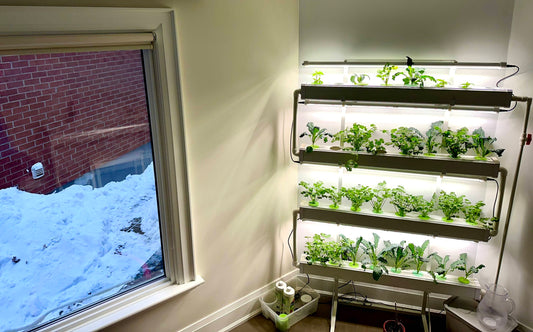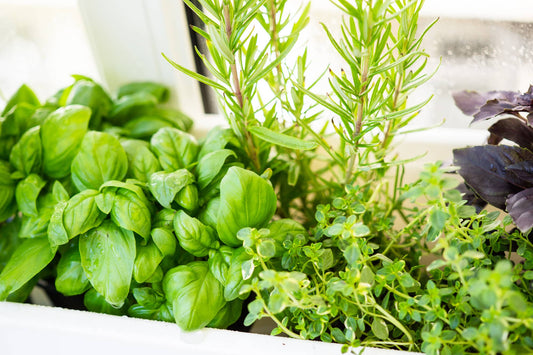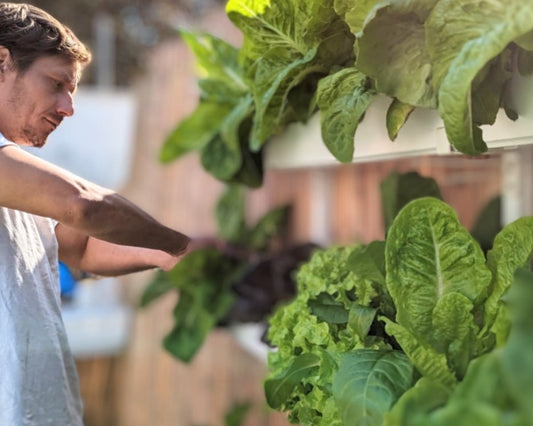Hydroponics offers an innovative way to grow fresh, healthy produce at home, providing a soil-free solution that is both efficient and space-saving. With several hydroponic methods available, choosing the right system depends on your space, goals, and the types of plants you wish to grow. Here, we break down four popular hydroponic methods, explaining how they work, their advantages, and which Nature Tech system is best suited for each approach.
1. The Dutch Bucket Method
The Dutch Bucket method, also known as the bato bucket system, is a versatile and proven approach, especially for growing large fruiting plants such as tomatoes, cucumbers, watermelons, and melons. Originating from commercial agriculture, it is ideal for home growers who want a professional-grade system that fits into a sunny corner of their space.
How It Works
This system uses individual buckets with an 11-liter capacity, providing ample space for roots to grow. Nutrient-rich water is delivered to the plant’s roots through a dripper at the top of the bucket. Any excess water drains through a siphon at the bottom and recirculates back to the reservoir, creating an efficient closed-loop system.
The buckets can be filled with various growing media, such as coconut coir, perlite, or clay pebbles. Alternatively, the system can be used without media, allowing roots to hang freely in the air.
Advantages
- Room for Growth: Each bucket offers ample space for roots to develop, ensuring healthy, robust plants.
- Ideal for Large Plants: This method is perfect for crops like tomatoes and melons that require substantial room to thrive.
- Water Efficiency: The recirculating system conserves water and nutrients.
- Commercial-Grade Reliability: Widely used in professional greenhouses, this system is proven to deliver consistent results.
- Best Fit
The Dutch Bucket system is ideal if you want to grow large plants in a sunny corner of your home. For a ready-to-use option, Nature Tech’s Tobato 5 system supports 5 to 20 plants and includes all necessary components for easy assembly. Compact and efficient, it’s perfect for private homes. Learn more or buy here.
2. The Nutrient Film Technique (NFT)
The NFT method is one of the most efficient hydroponic systems, particularly for growing leafy greens, herbs, and other smaller plants. This system maximizes space and uses a thin film of nutrient-rich water to deliver essential nutrients to the plant roots.
How It Works
In an NFT system, plants are placed in long, narrow channels with their roots suspended in the air. A thin film of water flows continuously along the bottom of these channels, ensuring the roots receive a constant supply of nutrients and oxygen. The water is recirculated, making this method highly efficient.
Advantages
- Space-Saving Design: Ideal for growing many plants in a small area.
- Highly Efficient: Minimal water and nutrient use due to recirculation.
- Fast Growth: Continuous nutrient delivery promotes rapid plant development.
Best Fit
This system is perfect for those who want to grow a variety of leafy greens in a small corner with 3-5 hours of sunlight or sufficient grow lights. Nature Tech’s Homie 28 system is an excellent choice, providing everything you need to cultivate up to 28 plants efficiently. Learn more or buy here.
3. The Shallow Water Culture (SWC) Method
The SWC method is a beginner-friendly system that ensures plant roots remain hydrated even if there are interruptions in power or pump operation. This reliability makes it an excellent choice for areas with inconsistent electricity or solar-powered setups.
How It Works
SWC systems use a shallow layer of water, enriched with nutrients, to keep the plant roots submerged. The water is recirculated to conserve resources, but even if the pump fails, the shallow water layer ensures the plants stay hydrated and healthy.
Advantages
- Fail-Safe Design: Plants won’t dry out during power outages.
- Water Conservation: Like other hydroponic methods, it recycles water and nutrients.
- Beginner-Friendly: Simple setup and maintenance make it ideal for new growers.
Best Fit
The SWC method is ideal for growers who prioritize reliability and simplicity. Nature Tech’s Wally 32 system supports robust plant growth with a user-friendly design. Learn more or buy here.
4. The Drip System
The drip system is one of the most versatile hydroponic methods, suitable for a wide variety of plants, including herbs, leafy greens, and even fruiting vegetables. This method delivers nutrient-rich water directly to the plant’s roots, ensuring consistent hydration and nutrition.
How It Works
In a drip system, nutrient solution is dripped onto the growing media at the base of each plant. Excess water drains back into the reservoir and is recirculated. The growing media helps regulate root zone temperature and provides stability for the plant.
Advantages
- Versatile: Supports a wide range of plants.
- Temperature Regulation: Growing media helps maintain optimal root temperatures.
- Space-Efficient: Great for maximizing outdoor or balcony space.
- Water and Nutrient Efficiency: Excess solution is reused, minimizing waste.
Best Fit
This system is perfect for outdoor spaces with plenty of sunlight. Nature Tech’s Airponic Fruit Tower system is a compact, vertical solution designed to grow large numbers of plants efficiently. Learn more or buy here.
Conclusion
Hydroponics offers an efficient and innovative way to grow plants at home, with systems tailored to different needs and goals. From the Dutch Bucket system for large fruiting plants to the NFT method for leafy greens, each approach has its unique advantages. By choosing the right Nature Tech system, you can enjoy fresh, homegrown produce while maximizing your space and resources. Whether you’re a beginner or an experienced grower, there’s a hydroponic system that’s perfect for you.




